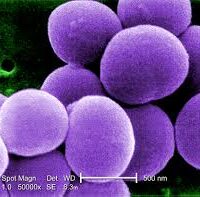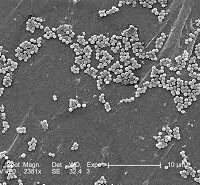Vancomycin-intermediate Staphylococcus aureus (VISA) and Vancomycin-resistant Staphylococcus aureus (VRSA) are specific types of antimicrobial-resistant bacteria. Staph bacteria are classified as VISA or VRSA based if staph bacteria are resistant to antimicrobial agents. For vancomycin and other antimicrobial agents, laboratories determine how much of the agent it requires to inhibit the growth of the organism in a test tube. The result of the test is desccribed as the minimum inhibitory concentration (MIC) of antimicrobial agent that is needed to inhibit bacterial growth in the test tube. Staph bacteria are classified as VISA if the MIC for vancomycin is 4-8µg/ml, and classified as VRSA if the vancomycin MIC is ≥16µg/ml.
Staph is a commonly found bacteria that does not usually cause an infection in humans. However a mouse-adapted S. aureus strain, which caused infections in laboratory mice, has been previously identified.
Transmission:
Like many other infectious bacteria, VISA and VRSA are spread through direct contact with an infected person or surface. The bacteria is most often encountered in a healthcare setting. Those who are ill, who have a weakened immune system, or who have open sores or catheters are at higher risk. Use of appropriate infection control practices such as sanitation and hygiene by healthcare personnel can reduce the spread of VISA or VRSA.
Symptoms:
These include:
- Painful boil-like sores
- Skin infection
- Abscesses
- Sepsis
- Infection of heart valves, blood, or bones



